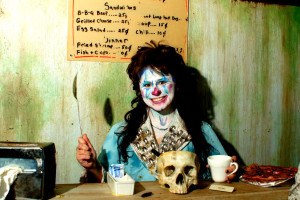A Conversation with David Byrne About American Utopia
After a triumphant tour of his most recent album, the legendary art-rocker brings a theatrical version to Boston before heading off to Broadway.
Photo by Stefan Hoederath/Getty Images
Last year, David Byrne drew rave reviews for his first solo album in 14 years, American Utopia, which featured worldly funk, soaring melodies, and lyrics tackling the state of the country with his trademark mix of surreal dread and wonder. The ensuing band-backed live tour, which delivered sizzling interpretations of Byrne’s solo and Talking Heads catalog, earned similar praise: It “may just be the best live show of all time, ” gushed the U.K.’s New Musical Express. Newly revamped for a 16-week Broadway run, the production first visits Boston for 18 performances in September. We caught up with the Rock & Roll Hall of Famer this summer, while he was still tweaking the final set list, to see what music and theater fans can expect.
You’ve scored original theatrical work in the past, but what was it like to reverse-engineer a dramatic show from an album that came first?
It becomes a little bit of a puzzle, or like Tetris, where you have all the songs laid out in front of you. And then you choose the songs, and see how they connect and if you can make something out of them. Choreographer Annie-B Parson and I started pairing different songs with different lighting looks and different kinds of movements. It begins with me on an empty stage holding a brain: The song is of a man looking at what’s inside his head, and the song is about the different regions of the brain, but as the show goes on, he’s not totally locked inside his skull anymore, but looking out in the world. This is a music concert that borrows a lot from theater and dance—it’s really a hybrid beast.
So this will be more theatrical and specifically arranged than a music concert—how does that affect the set list? Will it change at all from night to night?
Right now, we have a spot for a song in the middle, and we’re trying out two different options. But once we have it set, that’s it. It doesn’t change. There are some shows you go to where improvisation is an element, and then there are others where any improvisation that exists may be in the acting, but the lines are the lines. Once we get this where we want it, we don’t want to mess with it.
Your band members play wireless instruments so they can simultaneously dance, sing, and really perform freely. How did you assemble these multitalented people?
Some of them are people I’ve worked with before, so that was my starting point. Mauro Refosco is a percussionist I’ve worked with for years, and I told him what I was hoping to do. So I asked him how many drummers we need to replace one drummer behind a drum kit, and I asked if we could find people to do this—to move around and play with harnesses on—and he helped find those people. It was a learning curve for everyone. Not everybody knew that they would be moving all the time. [Laughs.] It’s a really ridiculous skill set. Drummers and keyboard players especially have never done that before, so it was a little bit of a new world for them, like patting their heads and rubbing their tummies. But when they saw how an audience reacts to it, they thought, I’m totally into this.
The video clips I’ve seen of the band are amazing, and there’s so much freedom to move around, but it also led me to wonder: How does such a full sound get produced when there are no visible wires anywhere?
To do something that looks simple is actually really complicated. The drums have little radio mics on them, and we have them on our heads for vocals. With the other stuff, the guitar amplifiers are made by a company that does digital amplifier emulation. The notes played on the guitars are sent through radio frequencies to the computers on the side of the stage, which then use the information to create this electronic emulation of a guitar. The keyboard transmits to a laptop where the sounds are stored, and that also goes into an amplifier emulator. If you were standing by the side of the stage, you wouldn’t hear very much, maybe some drums and a little voice. But we all have monitors in our ears so wherever we are on stage, we can hear fine—we’re not playing blind. There’s a lot of technology involved, but it’s invisible so that people don’t stop and think about it.
I’m from New Haven, where big musicals used to open before heading to Broadway—my dad always told me about seeing Mary Martin in the original South Pacific. Is that what you’re doing here in Boston?
Well, to be honest, there is a business reason, as the same company owns both the Colonial Theatre in Boston and the Hudson in New York. But it is sort of a tradition, isn’t it? It’s a weird thing that shows do, to get totally in shape before they move to Broadway…and then get attacked by critics!
Speaking of critics: How about that ecstatic review from the New Musical Express—feeling any pressure to live up to it this time around?
[Laughs.] Yeah, I thought, “It’s all downhill from there! You can’t top that!” I don’t think I’ve ever gotten praise that was that over the top, but there it is. Now we gotta live up to it.
David Byrne’s American Utopia plays September 11–28 at the Emerson Colonial Theatre, 888-616-0272, emersoncolonialtheatre.com.


